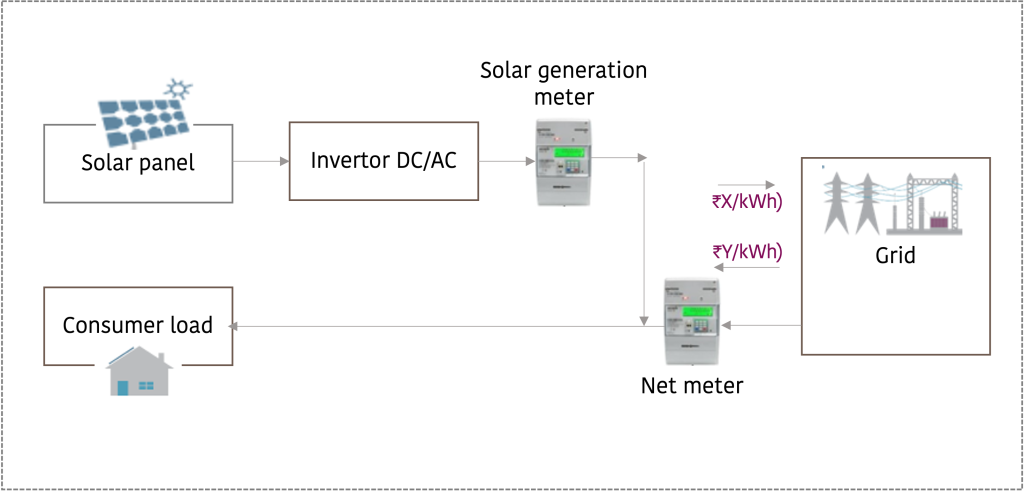In 2015, the Government of India set an ambitious renewable energy capacity target of 175 gigawatts (GW) by 2022 to transition towards a low-carbon energy system. Out of this, 40 GW was expected to be achieved through decentralized and rooftop solar installations. However, according to a report by IEEFA, as of today, rooftop solar accounts for only 14% of the total solar capacity installed in India, which is significantly below the planned target.
The adoption of rooftop solar in various Indian states has been driven by high retail electricity tariffs for commercial and industrial (C&I) consumers, favorable net metering policies, corporate social responsibility (CSR) programs, and growing consumer awareness. As per a report by CEEW (November 2019), 17 states have implemented net metering, whereas 19 states have adopted both net metering and gross metering mechanisms.
Net metering
Net metering allows consumers to generate their own electricity using rooftop solar panels and use it for their consumption. If the solar generation exceeds the consumer’s energy needs, the surplus electricity is exported to the grid. Conversely, if the electricity demand exceeds solar generation, the consumer draws the additional power from the grid.
 At the end of the billing cycle, the consumer is billed only for the net electricity consumption, which is calculated as:
At the end of the billing cycle, the consumer is billed only for the net electricity consumption, which is calculated as:
Net consumption = Total energy consumed – Solar energy exported to the grid
This mechanism helps reduce electricity bills by offsetting energy imported from the grid with the energy exported to the grid. Any excess generation beyond the consumption is usually compensated at a pre-determined rate set by the respective state electricity regulatory commission.
Gross metering
Under the gross metering mechanism, all the electricity generated by the solar power system is directly fed into the grid, and the consumer purchases the required electricity from the grid at the prevailing retail tariff.
 At the end of the billing cycle, the consumer receives compensation for the total electricity injected into the grid based on a Feed-in Tariff (FiT) determined by the state electricity regulatory commission.
At the end of the billing cycle, the consumer receives compensation for the total electricity injected into the grid based on a Feed-in Tariff (FiT) determined by the state electricity regulatory commission.
Unlike net metering, where consumers can offset their energy consumption with self-generated electricity, gross metering treats solar energy production and electricity consumption as separate transactions.
Key financial comparison
- Net metering case
- The consumer pays for the net electricity consumed from the grid at the retail tariff (e.g. ₹9 per kWh).
- Any surplus electricity exported to the grid is compensated at the Average Power Purchase Cost (APPC) (e.g. ₹4 per kWh).
- Gross metering case
- The consumer gets compensated at APPC (or FiT) for the total solar energy injected into the grid.
- The consumer purchases power from the grid at the standard retail tariff, which is usually higher than the compensation received for the exported solar energy.
Mathematical expression to understand net and gross metering
| Net metering | Dec | Jan | Feb |
|---|---|---|---|
| Consumer consumption imported from grid (kWh) (A) | 800 | 1000 | 1300 |
| Solar generation exported to grid (kWh) (B) | 800 | 1200 | 900 |
| Net energy (kWh) (C = A – B) | 0 | -200 | 400 |
| Payment by DISCOM (INR) (C * ₹4/kWh) | 0 | ₹800 | – |
| Payment by consumer (INR) (D * ₹9/kWh) | 0 | ₹3600 |
| Gross metering | Dec | Jan | Feb |
|---|---|---|---|
| Consumer consumption imported from grid (kWh) (A) | 800 | 1000 | 1300 |
| Solar generation exported to grid (kWh) (B) | 800 | 1200 | 900 |
| Payment by DISCOM (INR) (C = B * ₹4/kWh) | 3200 | 4800 | 3600 |
| Payment by consumer (INR) (D = A * ₹9/kWh) | ₹7200 | ₹9000 | ₹11700 |
| Net payment by consumer (INR) (E = D – C) | ₹4000 | ₹4200 | ₹8100 |
Conclusion
- Net metering is more financially beneficial for consumers as it offsets their electricity consumption, thereby reducing their power bills.
- Gross metering is better suited for large-scale solar producers who primarily aim to sell electricity to the grid rather than offset their own consumption.

